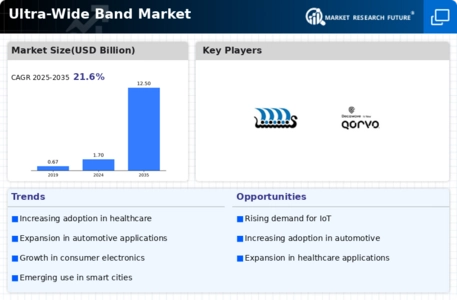Top Industry Leaders in the Ultra WideBand Market

Competitive Landscape of Ultra-Wide Band Market:
The Ultra-Wide Band (UWB) market is witnessing intense competition with several key players vying for market dominance. As of the latest assessment, prominent companies are strategically positioning themselves to capitalize on the growing demand for UWB technology across various industries. The competitive landscape is characterized by a mix of established players and emerging entrants, each employing distinctive strategies to gain a competitive edge.
Key Players:
- Taiyo Yuden Co Ltd. (Japan)
- 5D Robotics Inc. (US)
- Pulse LINK Inc. (US)
- Alereon Inc. (US)
- Johanson Technology Inc. (US)
- Nanotron Technologies GmbH (Germany)
- DecaWave Ltd. (Ireland)
- Fractus Antennas S.L. (Spain)
- BeSpoon SAS (France)
- Zebra Technologies Corporation (US)
Strategies Adopted:
- Product Innovation: Key players are heavily invested in continuous innovation, developing advanced UWB solutions to meet evolving market demands. This involves the integration of UWB technology into diverse applications, such as IoT devices, automotive systems, and healthcare equipment.
- Strategic Partnerships: Collaborations and partnerships play a pivotal role in the UWB market. Companies are forming strategic alliances with other industry leaders, startups, and research institutions to harness collective expertise and accelerate the development and adoption of UWB technology.
- Market Expansion: To maintain and expand their market share, companies are actively exploring new geographies and industries. This includes targeting emerging markets and diversifying applications to maximize the reach and impact of UWB technology.
- Ecosystem Integration: Some key players, particularly those with a strong presence in consumer electronics, are integrating UWB into their broader product ecosystems. This strategy aims to create seamless connectivity and interoperability between devices, enhancing the overall user experience.
Factors for Market Share Analysis:
- Technological Advancements: Companies investing in cutting-edge UWB technologies gain a competitive advantage. The ability to offer solutions with higher precision, lower power consumption, and enhanced data rates positions a company favorably in the market.
- Application Diversification: The breadth of applications addressed by a company's UWB solutions is a critical factor. Those catering to a wide range of industries, including automotive, healthcare, and smart homes, are better positioned to capture a larger market share.
- Global Reach: The ability to establish a global footprint is crucial. Companies with a strong international presence can tap into diverse markets, mitigating risks associated with regional economic fluctuations and market saturation.
- Comprehensive Ecosystem: Players that can provide end-to-end solutions and seamlessly integrate UWB technology into existing ecosystems are more likely to capture a significant market share. This involves compatibility with other communication protocols and devices.
New and Emerging Companies:
- Bespoon: This French startup specializes in UWB technology, offering high-precision real-time location systems (RTLS) for industrial and consumer applications.
- Jiobit: Focused on the location tracking market, Jiobit utilizes UWB technology for enhanced accuracy in tracking people and assets. The company's solutions cater to both consumer and enterprise segments.
- Zebra Technologies: While known for its barcode and RFID solutions, Zebra Technologies has entered the UWB market with applications in asset tracking and real-time location services.
Current Company Investment Trends:
- R&D Investments: Key players are allocating substantial resources to research and development to stay ahead in terms of technological innovation. This involves not only improving existing UWB solutions but also exploring new applications and use cases.
- Acquisitions and Mergers: The UWB market has witnessed a series of strategic acquisitions and mergers, allowing companies to expand their product portfolios and acquire complementary technologies. This trend is indicative of the industry's consolidation phase.
- Market-specific Investments: Companies are making targeted investments to address the unique needs of specific industries. For example, investments in UWB for automotive applications focus on enabling advanced driver-assistance systems (ADAS) and in-cabin monitoring.
- Capacity Expansion: With the increasing demand for UWB-enabled devices, companies are investing in expanding their manufacturing and production capacities. This ensures the ability to meet the growing market demand efficiently.
Latest Company Updates:
Oct 26: NXP Semiconductors and Bosch Sensortec announce collaboration to develop advanced UWB positioning technology for automotive and industrial applications. This partnership aims to create next-generation solutions for secure vehicle access, automated parking, and precise indoor navigation in factories.
Oct 20: FiRa Consortium publishes first UWB interoperability guidelines, paving the way for wider adoption and seamless device communication. These guidelines ensure compatibility between different UWB chipsets and devices from various manufacturers.
Oct 17: Apple releases iOS 17 update with enhanced UWB features, including improved indoor positioning accuracy and new AirDrop functionalities. This update further strengthens Apple's commitment to UWB technology and its integration into the iOS ecosystem.

